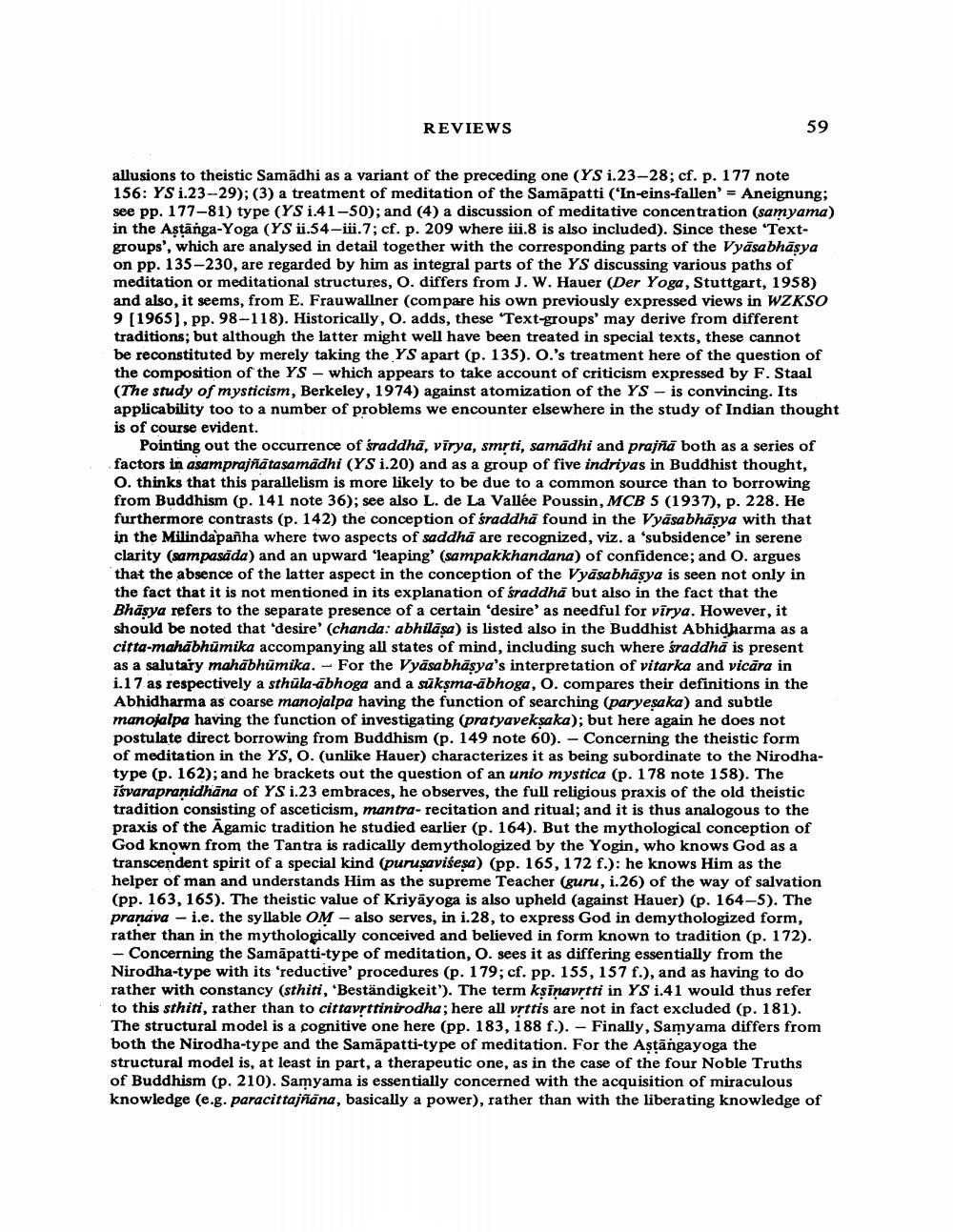Book Title: Book Reviews Author(s): J W De Jong Publisher: J W De Jong View full book textPage 1
________________ REVIEWS 59 allusions to theistic Samādhi as a variant of the preceding one (YS i.23-28; cf. p. 177 note 156: YS 1.23-29); (3) a treatment of meditation of the Samāpatti ("In-eins-fallen' = Aneignung; see pp. 177-81) type (YS 1.41-50); and (4) a discussion of meditative concentration (samyama) in the Astānga-Yoga (YS 1.54-iii.7; cf. p. 209 where iii.8 is also included). Since these 'Textgroups', which are analysed in detail together with the corresponding parts of the Vyasabhāsya on pp. 135-230, are regarded by him as integral parts of the YS discussing various paths of meditation or meditational structures, O. differs from J. W. Hauer (Der Yoga, Stuttgart, 1958) and also, it seems, from E. Frauwallner (compare his own previously expressed views in WZKSO 9 [1965), pp. 98-118). Historically, O. adds, these "Text-groups' may derive from different traditions, but although the latter might well have been treated in special texts, these cannot be reconstituted by merely taking the YS apart (p. 135). O.'s treatment here of the question of the composition of the YS - which appears to take account of criticism expressed by F. Staal (The study of mysticism, Berkeley, 1974) against atomization of the YS - is convincing. Its applicability too to a number of problems we encounter elsewhere in the study of Indian thought is of course evident. Pointing out the occurrence of sraddhā, vīrya, smrti, samadhi and prajñā both as a series of factors in asamprajñātasamadhi (YS i.20) and as a group of five indriyas in Buddhist thought, O. thinks that this parallelism is more likely to be due to a common source than to borrowing from Buddhism (p. 141 note 36); see also L. de La Vallée Poussin, MCB 5 (1937), p. 228. He furthermore contrasts (p. 142) the conception of sraddhā found in the Vyasabhāsya with that in the Milindapañha where two aspects of saddha are recognized, viz. a 'subsidence' in serene clarity (sampasāda) and an upward 'leaping' (sampakkhandana) of confidence; and O. argues that the absence of the latter aspect in the conception of the Vyasabhasya is seen not only in the fact that it is not mentioned in its explanation of sraddha but also in the fact that the Bhäsya refers to the separate presence of a certain 'desire' as needful for virya. However, it should be noted that desire' (chanda: abhilasa) is listed also in the Buddhist Abhidharma as a citta-mahābhūmika accompanying all states of mind, including such where sraddhā is present as a salutary mahābhūmika. For the Vyasabhāsya's interpretation of vitarka and vicāra in i.17 as respectively a sthūla-ábhoga and a sūksma-ābhoga, O. compares their definitions in the Abhidharma as coarse manojalpa having the function of searching (paryesaka) and subtle manojalpa having the function of investigating (pratyaveksaka); but here again he does not postulate direct borrowing from Buddhism (p. 149 note 60). - Concerning the theistic form of meditation in the YS, O. (unlike Hauer) characterizes it as being subordinate to the Nirodhatype (p. 162); and he brackets out the question of an unio mystica (p. 178 note 158). The isvarapranidhāna of YS 1.23 embraces, he observes, the full religious praxis of the old theistic tradition consisting of asceticism, mantra- recitation and ritual; and it is thus analogous to the praxis of the Āgamic tradition he studied earlier (p. 164). But the mythological conception of God known from the Tantra is radically demythologized by the Yogin, who knows God as a transcendent spirit of a special kind (purusavisesa) (pp. 165, 172 f.): he knows Him as the helper of man and understands Him as the supreme Teacher (guru, i.26) of the way of salvation (pp. 163, 165). The theistic value of Kriyāyoga is also upheld (against Hauer) (p. 164-5). The pranava - i.e. the syllable OM - also serves, in i.28, to express God in demythologized form, rather than in the mythologically conceived and believed in form known to tradition (p. 172). - Concerning the Samāpatti-type of meditation, O. sees it as differing essentially from the Nirodha-type with its 'reductive' procedures (p. 179; cf. pp. 155, 157 f.), and as having to do rather with constancy (sthiti, 'Beständigkeit). The term kşinavrtti in YS 1.41 would thus refer to this sthiti, rather than to cittavrttinirodha; here all vrttis are not in fact excluded (p. 181). The structural model is a cognitive one here (pp. 183,188 f.). - Finally, Samyama differs from both the Nirodha-type and the Samāpatti-type of meditation. For the Astängayoga the structural model is, at least in part, a therapeutic one, as in the case of the four Noble Truths of Buddhism (p. 210). Samyama is essentially concerned with the acquisition of miraculous knowledge (e.g. paracittajñana, basically a power), rather than with the liberating knowledge ofPage Navigation
1 2 3 4 5 6 7 8 9 10 11 12 ... 39
